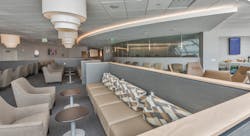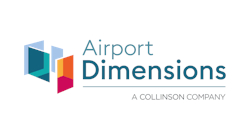Depart or transit from almost any international airport and you will be delighted to learn that there is a lounge option available regardless of the airline you are traveling on, the class of service you are flying, or your frequent flyer status. International airport directors and boards discovered the benefits of a ‘shared-use’ lounge option well over 25 years ago.
While the first airline lounge was opened in 1939 at what is now New York’s Laguardia airport, the U.S. airport lounge market has not kept up with the increasing demand for lounge alternatives. Since the opening of the first airline lounge over 75 years ago, many of the U.S. airports have depended on the airlines to provide a lounge experience for their travelers. The airlines developed loyalty lounge membership programs that were ultimately tied to their frequent flyer loyalty programs. These lounge membership programs allowed travelers flying in any class of service to enjoy the benefits of a private lounge experience. As the airline industry suffered from soaring costs and declining revenues, they began to open up their private lounges to a variety of customers outside of their loyalty membership audience. Day passes for the infrequent travelers and access via a variety of customer credit cards and other lounge membership programs increased. Now that the airline industry profits have begun to increase and airline frequent flyer program partnerships with key credit card and financial institutions have strengthened, airlines have begun to limit who is allowed access to their lounges. Airline lounges have become increasingly more ‘exclusive’ leaving thousands of travelers without an option to gain access to an airport lounge experience.
As access to airline lounges is becoming increasingly more difficult and expensive, the demand from travelers for lounge alternatives is growing. In a frequent flyer "Airport Experience" survey published in May 2016 by Priority Pass, travelers from seven countries confirmed that an airport lounge is viewed as a sanctuary from the stress of travel.
The survey respondents indicated that the airport does not simply provide an opportune moment for last minute shopping; for business flyers it has become a sanctuary ahead of a long flight thanks to the convenience of the airport lounge. Nearly two-thirds (59 percent) of frequent business flyers consider access to a premium airport lounge to be an "important" or "very important" factor when selecting an airport, with 40 percent admitting to going straight to the lounge and avoiding the shops altogether.
The research found that 51 percent of frequent business flyers actively enjoy the airport experience. This is a high percentage when you consider the fact that the business flyer is traveling for work purposes and does not have the relaxation of a typical leisure trip to look forward to on arrival. The airport lounge clearly has an important role to play here, offering a rare moment of tranquillity or the ability to stay connected in a peaceful and convenient environment.”
What is driving increased airport lounge demand – why is it important to your airport?
Increased passenger demand for access to a shared-use lounge is being driven by three important factors.
- Airline lounges have become increasingly more exclusive and costly.
Airlines have increased their lounge membership and day pass rates making it less appealing to many travelers.
Exclusive credit card partnerships are restricting access to passengers with competing credit cards.
Airlines are making significant lounge improvements with substantial capital investment to ensure they retain their most important travelers and convert their competitors travelers. The airlines wish to differentiate their most important travelers airport experience with their lounge product.
- New international airlines and increased international travelers
The growth of new international carriers to the U.S. brings an airplane full of "lounge savvy" travelers who expect to find a lounge available to enhance their airport experience. The Federal Aviation Aerospace 2016-2036 predicts that international passengers traveling to/from the U.S. will increase over 16 percent between 2016 and 2020. That growth is projected to continue to well over 100 percent by 2036.
Passengers traveling to/from the Pacific will increase over 19 percent and from the Atlantic over 18 percent between now and 2020.
Not only are these passengers looking for an airport lounge experience, the airlines bringing these travelers demand a lounge experience for their most important customers.
- Constrained airport terminal real estate limits options to provide lounge space to new international airlines.
As demands for increased concessions grow it becomes increasingly difficult to dedicate adequate space to accommodate the lounge requirements of new international airlines. You limit your airport’s competitive position with new international airlines if you do not have a lounge solution to offer.
How does a shared-use lounge solve these challenges?
A shared-use lounge gives your airport a competitive edge with travelers and new international airlines. A true shared-use lounge provides an "inclusive" lounge experience for all travelers regardless of airline, class of service they are flying, credit card relationship, or frequent flyer status. An experienced and established airport lounge operator is adaptable and can tailor the lounge experience to meet the needs of your international airline premium customers, while welcoming your moderate to in-frequent travelers.
A shared-use lounge is an efficient use of limited real estate. It allows multiple airlines the ability to offer a lounge product to their most important customers. Allowing other travelers, such as Priority Pass members and Day Pass customer access enhances the value of your shared-use lounge and grows airport revenue because of increased guest volumes.
Increase non-aeronautical revenues with a shared-use lounge
While it is important that your shared-use lounge is located as close to your most important flight departures as possible, the lounge does not need to take away from your concession development. Shared-use lounges can be developed on mezzanine levels and areas less desirable for key concession operators.
There are a variety of financial propositions that can be applied to your shared use lounge. You determine which of the financial structures fits your airport’s concession strategy.
- A lease for square footage
- A concession revenue share
- A minimum revenue guarantee
- A combination of lease plus revenue share
Whatever option you choose, you are increasing your revenues and efficiently utilizing your limited terminal real estate.
How do you drive increased shared-use lounge revenue?
The secret to achieving your shared-use lounge revenue targets and increasing revenue is – guest volumes. As you plan your shared-use lounge it is imperative that you have accurate and reliable guest volume projections. This is critical in the lounge foot print size, seating capacity, and financial projections.
The most successful and financially sustainable U.S. shared-use lounges welcome a combination of contracted airline guests, Priority Pass membership guests, and Day Pass guests. The Priority Pass membership audience is critical to your shared-use lounge success. This membership audience of sophisticated and savvy travelers comprises the most elite echelons of airport and airline customers around the globe. They are avid users of airport lounges and seek travel experiences that are customer focused and provide "quality of separation" from the stressful aspects of travel.
As you look to enhance your passenger airport experience and increase airport revenues, the addition of a shared-use lounge ensures your airport will be viewed favorably by U.S. and global travelers and safeguards your competitive position with new airlines. Your shared-use lounge will complement your concession program and increase non-aeronautical revenues while enhancing your passenger experience and providing a relaxed sanctuary for the increasing number of travelers.
Nancy Knipp is the senior vice president of ALD and has a rich background in the airline and airport lounge industry, having held senior roles at American Airlines for over three decades, including president of the American Airlines Admirals Club.





